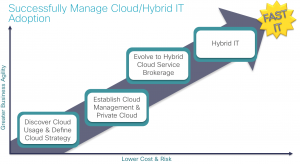As enterprise cloud use extends to public, private, and hybrid clouds, CIOs and IT leaders are realizing the need to evolve their IT business model to become enterprise cloud service brokerage (CSBs).
Cisco’s Scott Clark recently discussed the value of this new business approach for IT and highlighted that by adopting this approach IT can “provide the right private, hybrid or public cloud service, at the right time, and at the right cost.”
Most organizations are lagging behind in overhaul their business model and evolve into a CSB. Ovum came out with a report citing that only 50% of organizations participating had a cloud strategy in place and “only one-third or less of respondents said they have [cloud] governance, integration, or compliance strategies.”
IT organizations need to be thinking TODAY about how they will evolve their infrastructure and organization to become an enterprise CSB. Cisco Services has begun working with customers to outline the major milestones of this journey to evolve capabilities to become an enterprise CSB and manage hybrid IT environment.

Start By Understanding Your Cloud Usage & Creating a Unified Cloud Strategy
Most organizations do not understand how their employees are using cloud—typically there are 10-15 times more cloud services being used than IT is aware of. A successful cloud strategy starts by identifying what is already being used, including any shadow IT, and identifying future service needs.
With this understanding, IT organizations can then work with their lines of business to create a cloud roadmap that captures existing and future cloud infrastructure and services needs. This strategy also can outline a roadmap for implementing governance, integration, and risk/compliance strategies to manage cloud adoption at an enterprise-level. A unified cloud strategy can help to align lines of business with IT capabilities, and improve responsiveness of IT in providing future cloud service capabilities.
Institute Enterprise-wide Public Cloud Management and Establish A Cloud PMO
The next phase of the journey is to establish an enterprise-wide, lifecycle approach to managing cloud adoption. To drive this, organizations need to create a cloud program management office (PMO) or cloud team capable of managing enterprise public cloud operations.
A Cloud PMO should be responsible for establishing processes to onboard, manage, and eventually terminate cloud service providers. The Cloud PMO would also enforce risk and compliance mitigation processes, and establish a process for monitoring cloud usage across the organization, including public, private, and eventually hybrid clouds.
Explore Build Private Cloud Infrastructure
Enterprises likely need to put in place an infrastructure capable of introducing private cloud services for when organizations want to use cloud services to reduce license fees and total cost of ownership, but when the business risks of a using a public provider are too great. Private clouds can be built via pre-packaged, standardized private cloud implementations or highly customized private cloud services.
Evolve to Hybrid Cloud Service Brokerage
To help organizations connect with public and private cloud services that are centrally managed, organizations need to establish a cloud service catalog and charge back capabilities for cloud usage. With this in place, IT can then look at establishing a hybrid cloud infrastructure capable of seamlessly transitioning workloads to and between public and private clouds as well as ‘cloud burst’ when there is more service demand.
Inflection Point: Hybrid IT
The CSB business model helps an IT organization create and manage an ideal portfolio of services across private, hybrid and public and then optimize and innovate how they deliver these services. Organizations can establish policy-driven controls around service usage, and look towards hosted cloud infrastructures to reduce their overall costs and simplify management.
Ultimately, organizations can also begin to track cloud service usage and correlate usage with business outcomes. This provides the ability to understand which services have a positive outcome on an organization’s key performance metrics.
At this point, an organization reaches an inflection point for IT where they need to consider how they continue to manage cloud operations. Does the Cloud PMO structure make sense? Or has it become so central to IT working model that it is absorbed into a new organizational working model?
The journey to becoming a CSB can be complex. Cisco Services is working with IT leaders like you to help them transform into an enterprise CSB, and manage cloud adoption from end-to-end.
To learn more about avoiding the pitfalls of shadow IT and evolving IT into a cloud service brokerage, please register to attend an upcoming webinar on Dec 11, 2014 at 9:00 a.m. PT.
You said “Ultimately, organizations can also begin to track cloud service usage and correlate usage with business outcomes. This provides the ability to understand which services have a positive outcome on an organization’s key performance metrics.”
Typically, cloud management platforms (CMP) are designed with the needs of the IT organization in mind, so they likely will not be very useful in capturing data for these business-oriented KPIs. Do you anticipate that the CMP systems will evolve to address the needs and wants of LoB executives, eventually?
David,
Great question. The systems you describe, be they formally in the “cloud management” category today or future, must connect data on usage of cloud with the needs of the LoB executive. Just a basic of the future to help IT and the LoB correlate the best outcomes from SaaS, and even IaaS, for the LoB benefits, with the strategic sourcing approach IT will broker, be it from public, hybrid or private clouds.
We are certainly working toward such outcomes, be they derived from software, automation and analytics or professional services methods.
Thanks,
Robert